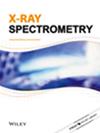Application research of monochromatic micro x‐ray fluorescence in glass physical evidence traceability
IF 1.5
4区 物理与天体物理
Q3 SPECTROSCOPY
引用次数: 0
Abstract
Micro‐x‐ray fluorescence (μ‐XRF) is a commonly used elemental analysis technique for glass physical evidence in forensic cases, which can detect major and trace elements in samples and potentially identify glass fragments according to the differences in elemental composition. However, when a sample is irradiated with polychromatic x‐rays, bremsstrahlung scattering from the source radiation provides noise in the fluorescence spectrum and affects the detection results. To improve the signal‐to‐noise ratio of the fluorescence spectrum, a Mμ‐XRF spectrometer constructed under the low‐power Mo target x‐ray tube condition was used to analyze ten kinds of common glass fragments. The application of laboratory Mμ‐XRF analysis in single‐point detection of tiny glass materials was studied. Experimental results show that the detection limit of Sr element was 51 μg/L, and the spectrometer can distinguish different types of small glass fragments according to the fluorescence spectrum information.单色微 X 射线荧光在玻璃物证溯源中的应用研究
显微 X 射线荧光(μ-XRF)是法医案件中玻璃物证常用的元素分析技术,可检测样品中的主要元素和痕量元素,并可根据元素组成的差异识别玻璃碎片。然而,当用多色 X 射线照射样品时,源辐射的轫致辐射散射会在荧光光谱中产生噪声,影响检测结果。为了提高荧光光谱的信噪比,在低功率 Mo 靶 X 射线管条件下构建了 Mμ-XRF 光谱仪,用于分析十种常见的玻璃碎片。研究了实验室 Mμ-XRF 分析在单点检测微小玻璃材料中的应用。实验结果表明,Sr 元素的检测限为 51 μg/L,光谱仪可根据荧光光谱信息区分不同类型的微小玻璃碎片。
本文章由计算机程序翻译,如有差异,请以英文原文为准。
求助全文
约1分钟内获得全文
求助全文
来源期刊

X-Ray Spectrometry
物理-光谱学
CiteScore
3.10
自引率
8.30%
发文量
38
审稿时长
6-12 weeks
期刊介绍:
X-Ray Spectrometry is devoted to the rapid publication of papers dealing with the theory and application of x-ray spectrometry using electron, x-ray photon, proton, γ and γ-x sources.
Covering advances in techniques, methods and equipment, this established journal provides the ideal platform for the discussion of more sophisticated X-ray analytical methods.
Both wavelength and energy dispersion systems are covered together with a range of data handling methods, from the most simple to very sophisticated software programs. Papers dealing with the application of x-ray spectrometric methods for structural analysis are also featured as well as applications papers covering a wide range of areas such as environmental analysis and monitoring, art and archaelogical studies, mineralogy, forensics, geology, surface science and materials analysis, biomedical and pharmaceutical applications.
 求助内容:
求助内容: 应助结果提醒方式:
应助结果提醒方式:


